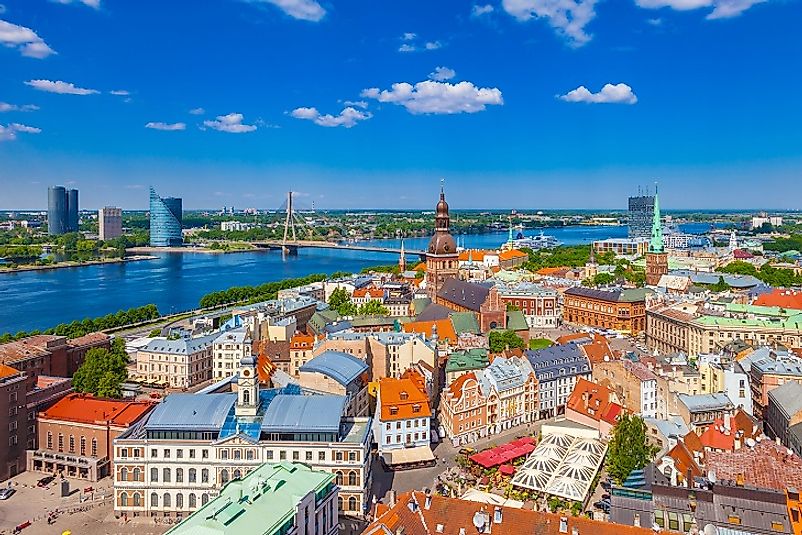Riga - Historic City In Latvia

5. Description and History -
The site of the city of Riga is known to have been settled since the early 2nd Century by the Livs people, who were an ancient Finnic tribe. During the early Middle Ages (6th to 10th Centuries AD) the area developed as a center of trade for the Vikings. In 1198 a group of crusaders, led by Berthold of Hanover (?-1198), started a campaign to forcibly Christianize the population of Livs from paganism. Although they were defeated and Berthold was killed this started the Wars against Livs and Latgalians (1198–1209) as part of the greater Livonian Crusade (1198-1290) which Pope Innocent III (1161-1216) declared. In 1201 Albert of Riga (c.1165-1229) landed at Riga with his crusades and quickly conquered the city and made it the seat of the Livonian bishopric. From 1201 until 1561 the city was a part of Terra Mariana (1207-1561), which was a condominium of the Archbishops of Riga and Livonian Order. After this is was a Imperial Free City of the Holy Roman Empire (962-1806) from 1561 to 1582, then part of the Polish-Lithuanian Commonwealth (1569-1795) from 1582 to 1629 and then a part of the Swedish Empire (1611-1721) from 1629 to 1721. The city was then part of the Russian Empire (1721-1917) from 1721 until 1917, when the German Empire (1871-1918) took the territory until 1918. After World War One ended Latvia became independent until 1940. During World War Two it became part of the Soviet Union (1922-1991) from 1940 to 1991, barring the period from 1941 to 1944 when Nazi Germany (1933-1945) controlled it. Since Latvia regained its independence from the Soviet Union Riga once again became its capital like it was the first time Latvia was independent.
4. Tourism -
The city of Riga was designated as a United Nations Educational, Scientific and Cultural Organization (UNESCO) World Heritage site in 1997, and is currently one of only two in the country of Latvia. The site also has hosted a lot of international events that would attract tourists like the 2003 Eurovision Song Contest, the 2006 IIHF Men's World Ice Hockey Championships, the 2014 World Choir Games and EuroBasket 2015. The city is also home to several notable theaters that are home to opera, drama and even puppet shows. The city also have a few notable sports arenas and several sports teams for hockey, soccer and basketball. The city is also home to the Riga Radio and TV Tower, which was built in 1989 and is the tallest structure in Latvia and all the Baltic States. The city is also home to Riga Castle, originally built in 1330, although it has been rebuilt and renovated several times over the centuries.
3. Architectural Uniqueness -
With the age of the city and the various groups that have occupied it over the centuries, Riga as a town reflects a variety of different architectural styles, which in turn reflect the city's evolution and development over time. Starting in the 1800s, the city rapidly industrialized, giving it most of the layout and architecture it has today. It was at this point the the suburbs surrounding the center of the medieval part of town were laid out as neoclassical style wooden buildings and then later as Art Nouveau style stone buildings by the early 1900s. Riga today has the highest concentration of Art Nouveau architecture in the world, with more then 350 buildings in the medieval area or historic center of town. This has led to the the city having a pretty well-preserved medieval core, a 19th Century style semi-circle of boulevards with a green belt on both sides and the former suburban area surrounding the boulevards with dense built-up areas, as well as the wooden architecture from the 18th and 19th Centuries.
2. Natural Surroundings, Sights, and Sounds -
As the largest city in Latvia, and in fact all of the Baltic states, Riga also has plenty of natural sights and sounds for visitors and residents alike to take in. The city sits on the Gulf of Riga at the mouth of the Daugava River as it goes out into the gulf and the greater Baltic Sea. The city has beaches that people can go and relax at as they take in the view of the Baltic Sea. Since it is such a large and old city Riga has a lot of old buildings with unique architecture to take in. The city also has all the sounds one would expect to fin from a major city with cars, buses, bikes, a nearby airport and also sea ferries.
1. Threats and Conservation Efforts -
The boundaries and buffer zones in the historic central part of the city of Riga fit in accordance with the sites necessary area as designated by UNESCO, and provide for an effective means of protection for the visual integrity of the site. One of the biggest threats to the integrity of the historic center of Riga are from the new development at the site that are of low quality and do not respect or represent the character, pattern or scale of the historic environment. The overall consistency of the site could also become vulnerable to new developments inside and outside the buffer zone. This could also effect the visual integrity of the site as high rise buildings could block the view of the historic center due to vast difference is height and scale.







